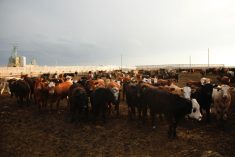MarketsFarm — Things are quiet right now on the chickpea front, but that could change in a few weeks, according to Jake Hansen of Mid-West Grain in Moose Jaw.
“I think everyone’s getting prepped and ready for Argentina’s harvest, but it’s quiet,” he said. “There’s still movement on previous contracts, but not a lot of new contracts materializing.”
While Hansen said chickpea purchases by exporters have slowed down in recent weeks, chickpea prices have gone up in all varieties compared to one year ago. Prices for kabuli chickpeas sized eight millimetres or larger increased anywhere between 2.3 and 7.8 cents per pound, to a range between 48 and 57.8 cents/lb. delivered, according to Prairie Ag Hotwire as of Monday. Eight-mm Kabulis went up four cents/lb. in price from last week and 5.3 cents/lb. from last month. Kabulis measuring seven mm went up in price by 3.8 cents/lb., to a range of 34 to 39.8 cents.
Read Also

Alberta crop conditions improve: report
Varied precipitation and warm temperatures were generally beneficial for crop development across Alberta during the week ended July 8, according to the latest provincial crop report released July 11.
Desi No. 1 chickpeas rose by 10 cents/lb. to between 36.5-40 cents, while B-90 No. 1 prices went up 3.8 cents/lb. to a range of 37.8-39.8 cents.
Hansen explained that lower yields for nine-mm Kabulis have supported prices.
“Turkey is short on their nine-mm production. The United States are short on their nine-mm production. Argentina was short on their nine-mm production and we were as well,” he said.
Canada produced 134,000 tonnes of chickpeas for the 2023-24 marketing year, 6,000 more than the year before, as increased planted area more than countered a decline in average yields, according to Statistics Canada data.
“The quality was probably some of the best Canada had ever seen. But while the quality was good, yields were lower,” Hansen said.
Exports for Canadian chickpeas are expected to fall from 225,000 tonnes in 2022-23 to 120,000 this year, according to the latest supply/demand estimates from Agriculture and Agri-Food Canada (AAFC) released Monday.
“We are seeing healthy export movement,” Hansen said. “Typically with exports, we see (healthy movement) from August to January or February and it hasn’t been different this year compared to last.”
Argentina’s harvest over the next month is expected to have a decent chickpea crop, according to Hansen, which could bring more price movement in the coming weeks.
“Kind of an average crop. We won’t know anything on sizing and we won’t know anything on overall quality until it’s cut and in the grain bin… Five or 10 per cent, plus or minus either way (for production),” he said.
— Adam Peleshaty reports for MarketsFarm from Stonewall, Man.




















